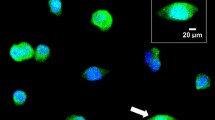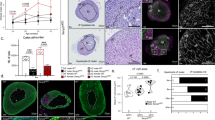Abstract
ADENOSINE-3′,5′-monophosphate (cyclic 3 ′,5′-AMP) has been shown to stimulate steroid C–11β hydroxylations in rat adrenal homogenates1 as well as the production of corticosterone from endogenous precursors in surviving rat adrenal sections2. In the latter instance, the effect of the cyclic nucleotide appeared to be related to enhancement of α-glucan phosphorylase activity3, consequent NADPH production, and, possibly, to increased provision of endogenous steroid substrate4. In homogenates, however, stimulation of steroid C–11β hydroxylation did not seem to be dependent on glycogen phosphorylation, NADPH generation, or the availability of endogenous precursors5. Since steroid C–11β hydroxylase activity is associated with adrenal mitochondria6, experiments were undertaken to determine whether cyclic 3′,5′-AMP was effective in isolated mitochondria. The data presented here reveal that the cyclic nucleotide was capable of stimulating C–11β hydroxylation of added progesterone and 11-deoxycorticosterone in purified adrenal mitochondria fortified with NADPH.
This is a preview of subscription content, access via your institution
Access options
Subscribe to this journal
Receive 51 print issues and online access
$199.00 per year
only $3.90 per issue
Buy this article
- Purchase on Springer Link
- Instant access to full article PDF
Prices may be subject to local taxes which are calculated during checkout
Similar content being viewed by others
References
Roberts, S., Creange, J. E., and Fowler, D. D., Nature, 203, 759 (1964).
Haynes, jun., R. C., Koritz, S. B., and Péron, F. G., J. Biol. Chem., 234, 1421 (1959).
Haynes, jun., R. C., J. Biol. Chem., 233, 1220 (1958).
Koritz, S. B., Biochim. Biophys. Acta, 60, 179 (1962).
Creange, J. E., and Roberts, S., Biochem. Biophys. Res. Comm., 19, 73 (1965).
Sweat, M. L., J. Amer. Chem. Soc., 73, 4056 (1951).
Brownie, A. C., and Grant, J. K., Biochem. J., 57, 255 (1954).
Lowry, O. H., Rosebrough, N. J., Farr, A. L., and Randall, R. J., J. Biol. Chem., 193, 265 (1951).
Makoff, R., Roberts, S., and Fowler, D. D., J. Biol. Chem., 239, 4124 (1964).
Nakamura, Y., and Tamaoki, B-I., Biochim. Biophys. Acta, 85, 350 (1964).
Brownie, A. C., Grant, J. K., and Davidson, D. W., Biochem. J., 58, 218 (1954).
Hirshfield, I. N., and Koritz, S. B., Biochemistry, 3, 1994 (1964).
Bueding, E., in Control of Glycogen Metabolism, edit. by Whelan, W. J., and Cameron, M. P., 247 (Churchill, London, 1964).
Author information
Authors and Affiliations
Rights and permissions
About this article
Cite this article
ROBERTS, S., CREANGE, J. & YOUNG, P. Stimulation of Steroid C–11β Hydroxylation in Adrenal Mitochondria by Cyclic 3′,5′-Adenosine Monophosphate. Nature 207, 188–190 (1965). https://doi.org/10.1038/207188a0
Issue Date:
DOI: https://doi.org/10.1038/207188a0
Comments
By submitting a comment you agree to abide by our Terms and Community Guidelines. If you find something abusive or that does not comply with our terms or guidelines please flag it as inappropriate.



